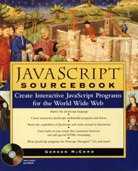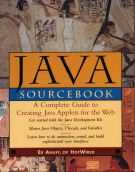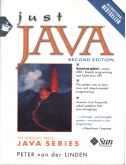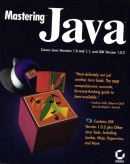Since bursting out onto the Internet in 1995, Java has become the most hyped and well-publicized programming language in history. Web surfers and everyone else alike seem to have heard of Java - even if they have no idea what it is or why it represents a revolution. However, for those familiar with Java, there is the sense that this new programming language for the Internet represents a step forward in computer history. Although many think of Java as the programming that enlivens Web pages with animation and other neat tricks, Java is really challenging the boundaries of networked computing today. The seven new books reviewed here provide a variety of perspectives on the ways in which Java will change the Internet and our ideas about computing. - Thomas E. Jevec, University of Illinois at Chicago, tej@well.com
Gordon McComb

JavaScript Sourcebook: Create Interactive JavaScript Programs for the World Wide Web
New York: Wiley, 1996.
726 p., paper with CD-ROM, ISBN 0-471-16185-3
Price $US44.95The JavaScript Sourcebook is a solid guide to building interactivity and multimedia into Web sites using JavaScript. As this book covers integrating JavaScript applications into HTML Web pages, it has a much wider appeal than many Java books available today. The focus here is on the much narrower, and less technical JavaScript language it is also much more accessible to a broad audience of both experienced and non-experienced programmers. The JavaScript Sourcebook covers everything needed to create and integrate JavaScript applications (the scripting language built into Netscape 2.0 and Explorer 3.0 ) into HTML. It starts with a good clarification of what JavaScript is and how it differs from the much more powerful and complicated Java programming language.
With a easy-to-follow tiered format, the book provides a clear presentation of JavaScript and its uses for Web site designers. Many examples of the limitations of HTML and JavaScript solutions are provided with detailed, real-life examples of popular Web page features. This basic material is accessible to anyone with a solid understanding of HTML. If you're ready to push the limits of your designs, there is a good section on advanced JavaScript applications. The best chapters of this book are Chapters 12 and 13 which contain easy to implement "How do I?" and "Plug and Play" JavaScript samples. The CD-ROM contains all of the samples and exercises presented in the book for quick implemention into Web pages.
The nice balance of non-technical and technical language will make this book appeal to many. It is a great starting point for non-programmers who want to take their Web sites further than "ordinary" HTML will allow. - tej
Ed Anuff

Java Sourcebook: A Complete Guide to Creating Java Applets for the Web
New York: Wiley, 1996.
498 p., paper, ISBN 0-471-14859-8
Price $US29.95An addition to the well-received Wiley Computer Publishing series, this book provides an introduction to Java programming for non-programmers and programmers alike. Unlike its companion JavaScript Sourcebook, this book tackles the full Java programming language, with a focus on Java programming for the Web.
The book starts with a clear introduction to the Java Development Kit (JDK) and then progresses from using Java to write trivial "fun stuff" to larger and more serious Java applications. Although the book claims that it "takes you as far (and fast) as you want to go," its focus is mostly limited to Java code for Web browsers, including extensive examples of animations and interactivity. Examples tend to be Netscape-centric and its description of the state of the Web is somewhat dated.
Although the Java Sourcebook is somewhat limited in its coverage of Java programming, it is very accessible to programmers who are starting with Java - especially those starting with the JDK - and those who want to start their programming with Web applets. -tej
Peter van der Linden

Just Java
Second edition
Upper Saddle River, N. J.: Prentice Hall, 1997.
538 p., paper, with CD-ROM, ISBN 0-13-272303-4
Price $US34.95Sure to be as popular in its second edition as its first, Just Java is the book for programmers who demand a comprehensive presentation of the Java programming language. Although Just Java is a thorough treatment of Java programming, it is highly relevant and just sheer fun to read.
This second edition of the second title in the SunSoft Press Java Series includes everything anyone learning Java needs to know, including new information on JDBC (Java database connectivity) and future APIs (application programming interfaces). The introduction to Java and object-oriented programming is the best I've read. Period. The exposition on what is new and different about the Java programming language makes this book useful for beginning programmers.
Packed full of examples, explanations, tips, techniques, "light relief" perspectives, and pointers to sources to learn more makes Just Java indispensable. Peter van der Linden literally brings a programming language to life and makes the reader want to read more. -tej
Jerry R. Jackson and Alan L. McClellan
Java by Example
Second edition
Upper Saddle River, N. J.: Prentice Hall, 1997.
386 p., paper with CD-ROM, ISBN: 0-13-272295-X
Price $US34.95Third in the SunSoft Press Java Series, Java by Example is a good book for getting started writing your first applets and applications. Aimed at programmers with a background in C and C++, Java by Example takes readers step-by-step through programming techniques from real-world experts using working Java code. In addition to the step-by-step building blocks, readers are brought to the point where the pieces and parts can be combined to create serious applications and applets.
Java by Example uses a reader-friendly design common to all five titles in the SunSoft Press Java Series employing useful indexes to tables and source code examples; a thorough introduction to Java; how to create original applets based on real examples; and, extensive appendices and an excellent quick reference. This is not a comprehensive Java manual, rather a practical guide to writing serious Java applets for the Web. -tej
Gary Cornell and Cay S. Horstmann
Core Java
Second edition
Upper Saddle River, N. J.: Prentice Hall, 1997.
766 p., paper with CD-ROM, ISBN: 0-13-596891-7
Price $US44.95Fourth in the best selling SunSoft Press Java Series, the second edition of Core Java is a technical manual for experienced C and C++ programmers who want to "leverage what you already know to get a fast start with Java." After a brief review of the fundamentals, Core Java launches into a full-scale and highly detailed treatment of the Java language. Core Java is not a book for those interested just adding animations and interactivity to their Web pages.
Providing all the essentials in one book, Core Java is a straightforward treatment of Java that begins with a realistic description of what Java is and what it is not. Although highly technical, it is easy to use and accessible. As in other books in this series, Core Java is full of examples, figures, and tables, coupled with nice indexes that make everything easy to locate. Most notable are the chapters on graphical user interface design, networking with Java, and future trends and developments for the Java language.
Core Java is a hard-core Java programming book intended for serious, experienced programmers and it delivers in these terms. -tej
Laurence Vanhelsuwe and others

Mastering Java
San Francisco: SYBEX, 1996.
967 p., paper with CD-ROM, ISBN: 0-7821-1935-2
Price: $49.99Mastering Java is a comprehensive resource including beginning to advanced resources for developing applets and applications. Although the book claims that no C or C++ programming experience is necessary, those without will definitely get less out of this book.
As a how-to and reference manual Mastering Java is a complete and concise guide to making sense out of the hype surrounding Java and explores the full potential of the language, from the core APIs (application programming interfaces) to security, database connectivity, applying Java classes, portability of Java applications, scaleability, and serious network applications. In addition to the scale of its treatment of Java, Mastering Java also stands out from other similar books in its review of third-party development tools, Java enabled programs, and helpful chapter summaries add extensive value.
Mastering Java assumes nothing in its explanations. It is the most comprehensive and thorough treatment of Java for programmers and non-programmers alike, under one cover. -tej
Brian Overlord
Java in Plain English
New York: MIS:Press, 1997.
552 p., paper, ISBN: 1-55828-503-2
Price:$16.95Java in Plain English stands out from other Java books as a useful reference manual and guide to advanced Java features. Aimed at experienced programmers (relating much of its content to C and C++ code), Java in Plain English assumes much in its presentation of the Java programming structure and application programming interface (API). A easy-to-follow introduction to what Java is provides a useful, but not unique or memorable, discussion of Java. Java in Plain English's other introductory chapters are also not especially helpful, though the design and layout of the book and examples are easier to follow than those in other Java titles. This book is outstanding, however, in its value as a reference manual for the experienced Java or C/C++ programmer. The alphabetical listing of API topics and the API quick reference are a much needed addition to the growing Java literature. The alphabetical listing of API topics is so useful because it describes each feature comparing it to C++, explains the syntax followed by an example. This scaled-back, "just the facts" approach will make this book heavily used by programmers ready to skip the narration.
Although the title Java in Plain English is somewhat misleading (Java Reference Companion would be more appropriate), this is a book that appeals to a wide range of users from beginners - wanting to supplement a comprehensive introduction to Java - as well as experienced programmers. -tej


Copyright © 1997, ° Á ® s º - m Û d @ ´